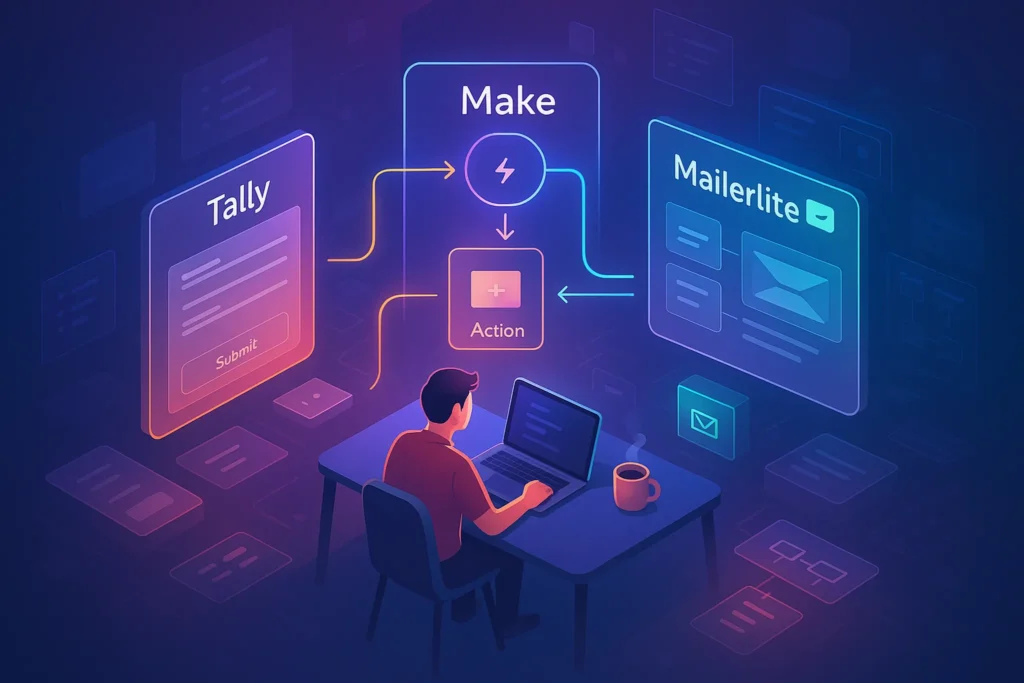🚀 Intro: Why Low Latency Matters for Growth Teams
In the fast-paced world of growth teams, speed isn’t a luxury—it’s survival. A lead who fills out your form today won’t wait hours for a follow-up email. A customer who completes payment expects instant confirmation. In this environment, automation tools like Zapier or Power Automate often face one big limitation: latency. Many no-code automation platforms rely on polling APIs, meaning they check every 5 or 15 minutes for new data. That delay might feel small, but in competitive markets where microseconds translate into lost opportunities, it’s a dealbreaker.
This is where webhooks come in. Instead of waiting for the next poll cycle, webhooks push data instantly, triggering actions in real-time. For growth teams that thrive on quick feedback loops, A/B testing agility, and immediate user engagement, webhooks can be the secret weapon that unlocks exponential efficiency.
💡 Nerd Tip: Imagine losing 20% of leads just because your automation system was 10 minutes late in sending them a welcome discount. Webhooks erase that gap.
If you’re just getting started with automation, it helps to build a foundation before diving into advanced concepts like webhooks. That’s where our guide on Workflow Automation 101 comes in—it walks you through the essentials of building automated systems, showing how simple triggers and actions evolve into scalable frameworks. By mastering the basics, you’ll better appreciate why webhooks matter as the next level of speed and precision.
🔎 What Are Webhooks?
At their core, webhooks are “reverse APIs.” Instead of asking an API, “Do you have something new for me?” every few minutes, a webhook sends the information immediately when something changes. Think of it like a doorbell. With APIs, you keep opening the door to check if someone’s there. With webhooks, the bell rings the second your visitor arrives.
For example, when a customer submits a lead capture form, a webhook can instantly send that data to your CRM. When a payment is completed, the webhook can trigger an invoice email without delay. APIs are powerful, but webhooks are smarter when the goal is real-time responsiveness.
The distinction matters: APIs excel at structured data retrieval, while webhooks shine in event-driven automation. Growth teams benefit when both are combined, but if latency is your bottleneck, webhooks are the tool to prioritize.
⚡ Why Webhooks Matter for Growth Teams
Growth teams operate in what’s often described as “high-frequency business.” Campaigns launch, feedback rolls in, and pivots happen daily. The difference between a webhook and traditional polling can be the difference between hitting or missing your conversion window.
Real-time synchronization means that user data flows directly from one system to another. A form submission triggers a Slack alert within a second, or a subscription payment instantly updates your analytics dashboard. Faster-than-polling execution makes the workflow feel alive, not delayed. And scalability is where webhooks really shine. Instead of setting up countless polling loops, one webhook can feed multiple workflows, reducing both API calls and costs.
A benchmark study from an automation SaaS provider showed that switching from polling-based triggers to webhook-based triggers cut integration delays from 10 minutes down to less than 500 milliseconds. That improvement translated into a 12% lift in conversion rate simply because users experienced faster responses.
💡 Nerd Tip: Webhooks aren’t just faster—they’re cheaper. Fewer API calls mean fewer credits burned on platforms that charge per task.
For creators looking to put automation into practice, Top Zapier Automations Every Creator Needs highlights real-world workflows that save time and cut repetitive tasks. Many of these examples can be enhanced with webhooks, giving you both inspiration and practical blueprints for streamlining your day-to-day work.
🛠 Common Use Cases for Webhooks
Webhooks sound abstract until you see them in action. They’re everywhere in modern growth operations:
When a lead capture form is submitted on your site, a webhook can push the details straight into your CRM instead of waiting for a scheduled sync. Payment processors like Stripe use webhooks to notify you instantly when a customer completes checkout or when a subscription renews. For marketing platforms, webhooks make it possible to stream campaign performance data into a data warehouse in real-time, enabling dashboards that update before your coffee cools. In customer support, a webhook can trigger automatic ticket creation in systems like Zendesk the second a user clicks “Help.”
These aren’t just conveniences—they’re competitive edges. If your team is still relying on polling automations, you’re already behind those who embrace webhook-driven systems.
🧩 Tools That Support Webhook Automation
The ecosystem of webhook-ready tools is richer than ever. Zapier and Make (formerly Integromat) both allow webhook triggers, letting you create instant workflows that bypass their usual polling limitations. Open-source automation frameworks like n8n and Pipedream are built with webhook-first architecture, making them attractive to developers and growth hackers alike. Even lightweight setups can benefit from custom scripts: a few lines of Node.js or Python are often all you need to capture and forward webhook events.
For teams who want to balance ease of use with flexibility, combining no-code platforms with webhook endpoints creates a sweet spot. For example, Zapier’s “Catch Hook” trigger allows any service to send data, while the rest of the Zap handles distribution. This way, non-technical marketers get real-time responsiveness without needing to code every piece of the puzzle.
💡 Nerd Tip: Don’t underestimate custom scripts. A $5/month VPS running a webhook listener can often outperform premium plans of no-code automation tools in speed and scale.
Platform choice is another big question for growth teams. Should you stick with Zapier, explore Microsoft’s Power Automate, or test IFTTT? Our breakdown—Zapier vs. Power Automate vs. IFTTT—helps you weigh the trade-offs. Reading it alongside this webhook guide clarifies when a no-code tool is enough and when a webhook-first approach becomes essential.
🧭 Setting Up a Webhook (Step by Step)
If you’re new to webhooks, the setup may look intimidating. But the reality is more straightforward than most tutorials make it seem. Here’s how it works in practice:
First, you generate a webhook URL. This is usually provided by your automation tool (Zapier, n8n, Make) or your own server. Think of it as a unique address where events will be delivered. Next, you go to the source platform—the app that will send the event—and paste in that webhook URL. For example, Stripe lets you add a webhook endpoint for “payment succeeded.” Once configured, you run a test. The platform will send a sample payload to your webhook URL so you can see the data structure. Finally, you map that data to actions. If the payload includes “email,” your automation can instantly forward it to your CRM.
The first time feels technical, but within a few setups, you’ll find it’s far simpler than trying to debug why a polling task missed an update.
⚖️ Pros & Cons of Webhooks vs Traditional Automation
Every growth tool has trade-offs, and webhooks are no exception. On the positive side, speed is unmatched. Data arrives instantly, giving you precision that polling can’t touch. Webhooks also offer flexibility—you choose the exact events you want to trigger workflows. Precision is another advantage. Instead of catching every possible update, you get only what matters.
But there are downsides. Webhooks require more technical setup compared to drag-and-drop polling tools. Error handling can also be tricky. If your server is down, the webhook may fail silently unless retries are built in. Debugging malformed payloads can frustrate non-technical team members.
Yet for growth teams chasing responsiveness and scale, the pros far outweigh the cons. Polling may be easier to start with, but webhooks are the foundation for a system that grows with you.
📊 Case Study: Cutting Latency, Boosting Conversions
A mid-sized SaaS growth team once relied on polling automations to sync trial sign-ups into HubSpot. The delay averaged around 10 minutes. During that time, potential customers were left waiting for a welcome email with onboarding instructions. Conversion from free trial to paid plan hovered at 7%.
After implementing webhooks, the latency dropped to under a second. The welcome email now landed instantly, and users reported being “pleasantly surprised by how fast the system responded.” Within three months, their trial-to-paid conversion rose to 9.5%—a relative 35% increase. The team credited webhooks for enabling them to capture the “moment of maximum intent.”
💡 Nerd Tip: The longer your system waits to engage a lead, the colder that lead becomes. Webhooks keep your touchpoints hot.
If you’re a solo founder or part of a remote-first startup, efficiency is your lifeline. That’s why our article on Best Workflow Automation Tools for Solopreneurs & Remote Teams is worth exploring. It maps out the lightweight yet powerful tools that complement webhook-driven systems, ensuring your automations stay both fast and manageable as your business scales.
⚡ Ready to Build Smarter Workflows?
Explore AI workflow builders like HARPA AI, Zapier AI, and n8n plugins. Start automating in minutes—no coding, just creativity.
📈 Benchmarks & Numbers: Polling vs Webhooks in Action
Numbers rarely lie, and when it comes to automation speed, the gap between polling and webhook approaches is measurable. Polling-based systems typically check every 5–15 minutes for updates. That sounds acceptable on paper, but when scaled across thousands of events, it quickly snowballs into inefficiency.
For instance, a SaaS team running polling integrations across 10 apps found they were generating nearly 50,000 API calls per month—most of them wasted on “no new data.” By switching to webhooks, they cut their API calls by over 70%, reducing infrastructure costs and freeing up API limits for more critical operations.
Latency also tells its own story. Polling every 15 minutes introduces an average wait time of 7.5 minutes before any action fires. Webhooks, on the other hand, deliver payloads in under 1 second. In customer-facing workflows, that can mean the difference between a warm lead and a lost lead. Real-world benchmarks show that instant automation boosts click-through rates by 8–12%, simply because users receive responses while they’re still engaged.
💡 Nerd Tip: If you want proof of ROI, track how many “lost leads” happen during automation delays. You’ll often find the numbers justify webhook adoption almost immediately.
🛡 Webhook Failure Modes & Recovery
Webhooks may be faster, but they’re not invincible. Understanding failure modes is key to building resilient automations. One common failure is timeouts—if the receiving server doesn’t respond quickly enough, the webhook call fails. Another is bad payloads, where unexpected data structures break the downstream process. And of course, downtime on the receiving end means missed events altogether.
Recovery strategies separate amateur setups from production-ready systems. Implementing retry policies ensures that failed webhook deliveries are automatically resent after a short delay. Queue systems, such as AWS SQS or RabbitMQ, can buffer incoming webhook events so that spikes in traffic don’t overwhelm the endpoint. Logging every webhook call, successful or not, provides a breadcrumb trail for debugging when things go wrong.
For growth teams, the takeaway is simple: speed without reliability is fragile. A strong webhook setup balances instant delivery with robust fallback mechanisms, ensuring that no mission-critical data slips through the cracks.
Finally, growth teams dealing with content at scale should check out Pro Tips for Automating Your Entire Content Workflow. From idea capture to publishing, it demonstrates how automation can eliminate bottlenecks across the creative pipeline. Combined with webhook integrations, this approach ensures your content machine never misses a beat—faster iterations, quicker feedback loops, and more consistent output.
🧭 Webhook Design Best Practices
To avoid common pitfalls, growth teams should adopt best practices when designing webhook systems. First, always verify the source. Most providers allow you to validate webhook calls with a secret key or signature. This prevents malicious actors from spoofing events.
Second, keep webhook payloads lightweight. Sending only the essential data reduces latency and avoids unnecessary parsing complexity. If more data is needed, use the webhook to trigger an API call for the full details. Third, embrace versioning. Just like APIs, webhook payloads can evolve. By tagging versions, you prevent older workflows from breaking when new fields are introduced.
Finally, test extensively. Use tools like RequestBin or your own staging endpoints to inspect webhook payloads before going live. Testing not only prevents errors but also builds confidence that your workflow will behave as expected under real-world conditions.
💡 Nerd Tip: Never assume webhook payloads will always look the same. Defensive coding and validation keep your automations bulletproof.
🏢 Industry Examples: Who’s Winning with Webhooks
Webhooks aren’t just a nerdy developer feature—they’re powering some of the biggest platforms in the world. Shopify relies heavily on webhooks to notify store owners of orders, refunds, and inventory changes. Without them, ecommerce workflows would crawl under polling delays. GitHub uses webhooks to trigger CI/CD pipelines the moment a commit is pushed, fueling the continuous delivery ecosystem.
Stripe is another well-known example. Their webhook-first architecture enables instant updates on payment events, making them the go-to choice for businesses where timing is critical. Even Slack’s app ecosystem thrives on webhooks, which allow bots and integrations to respond in real time.
The lesson for growth teams? If industry leaders are relying on webhooks to scale, the model is proven. You don’t have to reinvent the wheel—just adapt the same principles to your own workflows.
📊 Comparison Table: Webhooks vs APIs (Polling)
Here’s a quick side-by-side breakdown that highlights why webhooks outshine traditional polling in growth environments:
| Feature | Polling APIs | Webhooks |
|---|---|---|
| Speed | Delay of 5–15 min per cycle | Near-instant (sub-second) delivery |
| Efficiency | Wastes calls when no new data exists | Fires only when events occur |
| Scalability | Limited by API rate limits | Scales with minimal API overhead |
| Complexity | Easier for beginners | Requires more setup & validation |
| Reliability | Misses fast-changing events | Accurate, event-driven triggers |
| Cost | Higher (due to extra API calls) | Lower (uses fewer requests overall) |
💡 Nerd Tip: Use polling for low-priority tasks (like nightly reports), but use webhooks for user-facing, time-sensitive workflows where seconds count.
Want More Smart AI Tips Like This?
Join our free newsletter and get weekly insights on AI tools, no-code apps, and future tech—delivered straight to your inbox. No fluff. Just high-quality content for creators, founders, and future builders.
100% privacy. No noise. Just value-packed content tips from NerdChips.
🧠 Nerd Verdict
Webhooks aren’t just a technical feature—they’re a growth enabler. For teams that thrive on speed, responsiveness, and scalability, webhooks deliver the missing link that polling-based automation struggles to provide. By embracing webhook-driven workflows, growth teams position themselves to move faster, close more conversions, and scale integrations without drowning in delays.
The future of automation isn’t about checking every 15 minutes. It’s about being there the second something happens. And webhooks are how you get there.
❓ FAQ: Nerds Ask, We Answer
💬 Would You Bite?
If a webhook could cut your integration delay from minutes to seconds, how would that change your workflow?
Share your perspective—we’d love to hear how instant automation could reshape your team’s productivity. 👇
Crafted by NerdChips for creators and teams who want their best ideas to travel the world.



